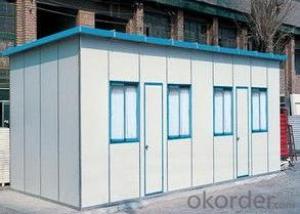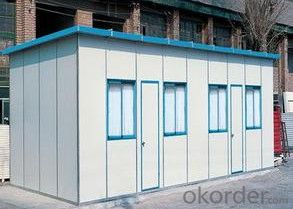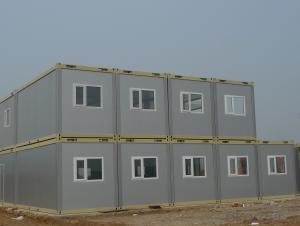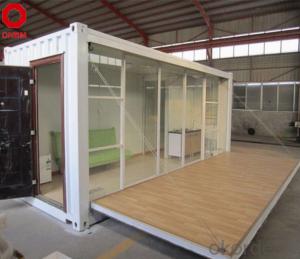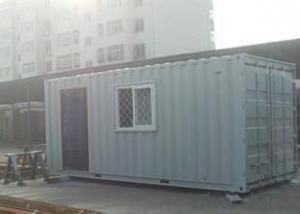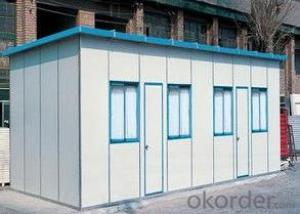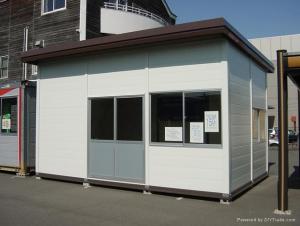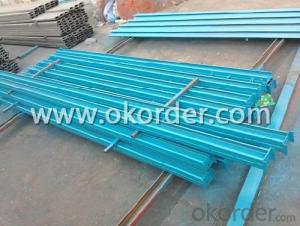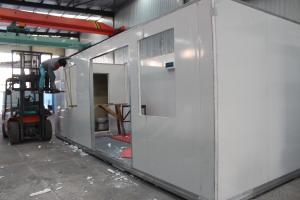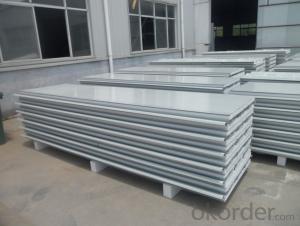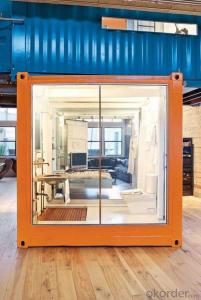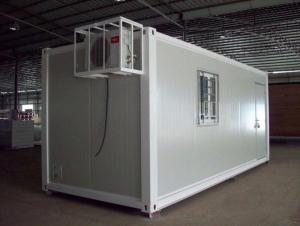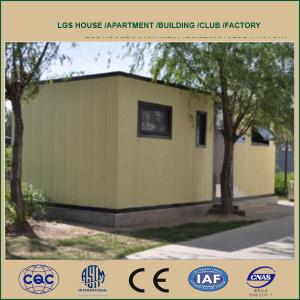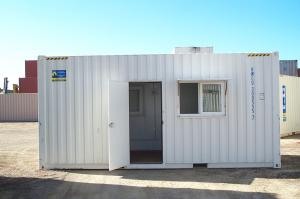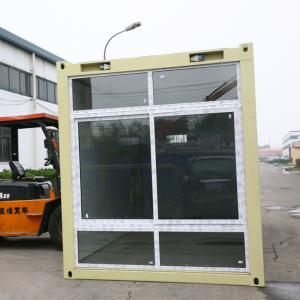Economic Modular Container Home
- Loading Port:
- Tianjin
- Payment Terms:
- TT OR LC
- Min Order Qty:
- -
- Supply Capability:
- 20000 Set set/month
OKorder Service Pledge
OKorder Financial Service
You Might Also Like
Economic Modular Container Home
Dimension |
(1)External diameter:L 6058mmX W 2438mmXH 2896mm (2)Internal diameter: L 5820mmXW 2200mmXH 2680mm |
Area | 15m2 or 30m2 or other size |
Color | White grey, blue---as your require |
Weight | 2000kg/20ft;4000kg/40ft |
Lifetime | 20-25 years |
Steel Frame | 4mm thickness steel pillar (baking finish)+3mm steel beam (Hot-galvanized) |
Wall Panel | 60mm EPS/Rockwool/PU sandwich panel |
Roof | (1)First layer: 0.5mm Hot-galvanized steel sheet (2)Second layer: 100mm glass wool insulation (3)Third layer: 50mm EPS/PU/Rockwool Sandwich Panel |
Bottom | (1)First layer:1.8 mm PVC floor (2)Second layer:18mm plywood for office,living etc. Cement fiberboard for bathroom with good water-proof (3)Third layer:100mm Insulation (4)Forth layer:0.5mm Hot-galvanized steel sheet |
Door/windows | one steel door and two PVC sliding windows |
Electricity | (1)1 distribution box;1 circuit breaker; (2)2 Ceiling lights ; 3 sockets(1 is A/C socket); (3)1 switch; |
Usage | Accommodation,office,living room,hotel,meeting room, dormitory, shop, booth, toilet, storage, kitchen, shower room and so on. |
Package | (1) 4 sets Flat-packing without shipping container (2) 6 sets loading in 40'High shipping Container; (3)The inner shower room and other furniture will be packed separately in shipping container. |
- Q: Are container houses resistant to high winds?
- Yes, container houses can be resistant to high winds. The structural integrity of container houses makes them inherently strong and able to withstand strong winds. Shipping containers are designed to withstand the rigors of transportation at sea, including high winds and rough seas. The steel structure of the containers, along with their corners being reinforced and welded, provides excellent resistance to wind forces. Moreover, container houses can be securely anchored to the ground, further enhancing their resistance to high winds. However, it is important to note that the overall resistance to high winds will also depend on the quality of construction and the specific design elements implemented in the container house.
- Q: Are container houses suitable for temporary event spaces or venues?
- Yes, container houses can be suitable for temporary event spaces or venues. Container houses are versatile and can be easily modified to fit the specific needs of an event. They can be transformed into open, airy spaces by removing walls and adding windows or doors. Additionally, containers can be stacked or arranged in different configurations, allowing for a customizable layout that can accommodate different types of events such as exhibitions, pop-up shops, or temporary restaurants. Container houses are also portable, making them convenient for events that require mobility or need to be relocated. Moreover, they are cost-effective compared to traditional event spaces, as containers are readily available, and the construction and setup time are significantly reduced. Overall, container houses offer a unique and innovative solution for temporary event spaces or venues, providing a modern and sustainable alternative to traditional structures.
- Q: How big is the container type?
- Second, durable, all composed of steel, with a strong anti-seismic, anti-deformation ability
- Q: Are container houses suitable for areas with limited access to medical facilities?
- Yes, container houses can be suitable for areas with limited access to medical facilities. These houses can be designed to meet the specific needs of the residents in terms of healthcare. They can be equipped with medical equipment and technologies, such as telemedicine systems, that allow for remote consultations with healthcare professionals. Additionally, container houses can be easily transported to different locations, making it possible to bring medical facilities closer to the residents in need.
- Q: Are container houses earthquake-resistant?
- Container houses can be designed to be earthquake-resistant, but it ultimately depends on the construction techniques and materials used. Shipping containers are made of steel, which is a strong and durable material. However, without proper reinforcement and modifications, they may not be able to withstand the forces generated during an earthquake. To make container houses earthquake-resistant, several measures can be taken. One common approach is to reinforce the containers with additional steel beams or frames. These provide extra structural support and help distribute the seismic forces more evenly throughout the building. Additionally, securing the containers to a strong foundation, such as concrete footings or pilings, can further enhance their stability during an earthquake. Other factors that contribute to the earthquake-resistance of container houses include the overall design and layout. For example, a well-designed structure with proper load distribution, bracing, and cross-connections can improve its ability to withstand seismic events. Furthermore, using flexible and lightweight materials for interior finishes can reduce the risk of falling objects and potential injuries during an earthquake. It's important to note that while container houses can be made earthquake-resistant, the level of resistance will vary depending on the specific design, location, and the magnitude of the earthquake. Consulting with structural engineers and following local building codes and regulations is crucial to ensure the safety and resilience of container houses in seismic-prone areas.
- Q: Can container houses be designed to have a home theater?
- Yes, container houses can definitely be designed to have a home theater. Container houses are highly versatile and can be customized to meet various needs and preferences. With proper planning and design, it is entirely possible to incorporate a home theater into a container house. To begin with, the dimensions of a container can be modified to accommodate the necessary space for a home theater. Containers can be joined or stacked to create larger living areas, allowing for a dedicated room for the home theater. Additionally, the interior layout can be customized to include features such as raised flooring for seating, soundproofing materials for enhanced acoustics, and specialized lighting to create a cinematic experience. Furthermore, container houses can be equipped with the necessary technology for a home theater setup. This includes installing a large screen or projector, surround sound speakers, and comfortable seating. The electrical and wiring systems can be appropriately designed to support the audio-visual equipment and ensure seamless connectivity. It is also important to consider the thermal and insulation requirements of a container house to ensure optimal comfort. Proper insulation and climate control systems can be incorporated to regulate the temperature and provide a cozy atmosphere for enjoying movies and entertainment. Ultimately, container houses offer ample flexibility in design and can be customized to suit individual preferences, including the incorporation of a home theater. With careful planning, creative design solutions, and the right technology, container houses can provide a unique and enjoyable cinematic experience right at home.
- Q: Are container houses suitable for areas with limited access to utilities?
- Yes, container houses are suitable for areas with limited access to utilities. Container houses are designed to be highly adaptable and can be equipped with various off-grid systems such as solar panels, rainwater harvesting, composting toilets, and propane tanks for cooking and heating. These off-grid solutions make container houses a viable option for areas with limited access to utilities, as they provide self-sufficiency and reduce reliance on traditional infrastructure.
- Q: Can container houses be designed with a walk-in closet or dressing room?
- Certainly, it is feasible to incorporate a walk-in closet or dressing room into a container house. The versatility and customizability of shipping containers for housing allow for such additions to be made according to individual requirements. Although space in container houses may be limited compared to traditional homes, the design can be optimized by creatively using the available area. Vertical space can be maximized by incorporating shelves, hanging racks, and storage solutions in the walk-in closet, thus maximizing storage capacity. Sliding or folding doors can also be utilized to save space and make the most of the available area. To accommodate a dressing room, the design of the container house can be adjusted accordingly. By strategically placing a mirror and vanity area, a separate space for getting ready and applying makeup can be created. This can be achieved by partitioning off a section of the container or by using a separate container module solely for the purpose of a dressing room. Ultimately, the feasibility of having a walk-in closet or dressing room in a container house depends on factors such as the overall design, size of the container, and the specific needs and preferences of the homeowner. However, with proper planning and customizations, it is certainly possible to have a functional and stylish walk-in closet or dressing room within a container house.
- Q: Can container houses be designed to have a traditional exterior appearance?
- Certainly, container houses can be specifically crafted to possess a traditional exterior look. By employing suitable design principles and architectural methods, container houses can effortlessly assimilate into conventional neighborhoods and imitate the appearance of regular homes. There are multiple ways to attain a traditional exterior appearance for container houses. One possible approach involves utilizing customary construction materials like brick, stone, or wooden siding to cover the exterior of the containers. This technique can contribute to creating a more familiar and visually appealing appearance. Furthermore, incorporating traditional architectural elements such as pitched roofs, dormer windows, porches, and decorative details can further enhance the traditional look of the container house. Another method is the employment of camouflage. By strategically positioning the containers and ingeniously disguising them with landscaping, such as the addition of plants, trees, or fences, the containers can be concealed from view and seamlessly blend into the surrounding environment. This approach allows for a traditional exterior appearance while still taking advantage of the structural benefits and cost-effectiveness of shipping containers. Moreover, interior design plays a vital role in establishing a traditional ambiance. By focusing on traditional furniture, fixtures, and finishes, the interior can complement the traditional exterior and create a unified design concept. It is crucial to note that designing a container house with a traditional exterior appearance necessitates meticulous planning, ingenuity, and the expertise of professionals in architecture and design. They can ensure that the structural integrity of the containers remains intact while achieving the desired traditional appearance. To conclude, container houses can be designed to possess a traditional exterior appearance through the utilization of traditional building materials, architectural elements, camouflage techniques, and appropriate interior design. By employing the right design approach, container houses can seamlessly integrate into traditional neighborhoods and offer an innovative and sustainable alternative to conventional housing.
- Q: Can container houses be financed?
- Yes, container houses can be financed. Many financial institutions, such as banks and credit unions, offer loans specifically for the construction or purchase of container houses. These loans are similar to traditional home loans, but may have some specific requirements related to the use of shipping containers as building materials. Additionally, some container house manufacturers or builders may offer financing options directly to their customers. It is important to research and compare different financing options to find the best terms and rates that suit individual needs.
Send your message to us
Economic Modular Container Home
- Loading Port:
- Tianjin
- Payment Terms:
- TT OR LC
- Min Order Qty:
- -
- Supply Capability:
- 20000 Set set/month
OKorder Service Pledge
OKorder Financial Service
Similar products
Hot products
Hot Searches
Related keywords
